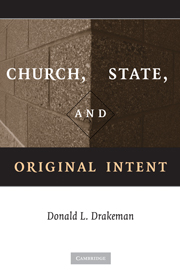Book contents
- Frontmatter
- Contents
- Preface
- 1 Introduction
- 2 Reynolds: The Historical Construction of Constitutional Reality
- 3 Everson: A Case of Premeditated Law Office History
- 4 The Battle for the Historical High Ground
- 5 Original Meanings: Where Is the Historical High Ground?
- 6 Incorporating Originalism
- 7 Conclusion
- Bibliography
- Index
2 - Reynolds: The Historical Construction of Constitutional Reality
Published online by Cambridge University Press: 05 June 2012
- Frontmatter
- Contents
- Preface
- 1 Introduction
- 2 Reynolds: The Historical Construction of Constitutional Reality
- 3 Everson: A Case of Premeditated Law Office History
- 4 The Battle for the Historical High Ground
- 5 Original Meanings: Where Is the Historical High Ground?
- 6 Incorporating Originalism
- 7 Conclusion
- Bibliography
- Index
Summary
In the Supreme Court's first case interpreting the Constitution's free exercise of religion clause, Chief Justice Morrison Waite endowed the next two centuries of church-state jurisprudence with a generous legacy of constitutional history. In that 1879 case, Reynolds v. United States, the chief justice called upon the Founding Fathers to decide whether polygamous Mormons in the Territory of Utah were immunized by their faith from prosecution under a federal statute outlawing bigamy. The Court's ruling offered Mr. Reynolds, a minor Mormon official, no hope of sanctuary within the First Amendment. More important than this specific decision, however, was the historical approach to interpreting the religion clauses adopted by the chief justice, which has had the effect of essentially writing Thomas Jefferson and James Madison directly into the First Amendment. Not just any aspects of these two influential framers were incorporated into constitutional doctrine, but their writings that have come to stand for the principle of a strict separation of church and state: two documents from colonial Virginia – Madison's Memorial and Remonstrance against Religious Assessments and Jefferson's Bill for Establishing Religious Freedom – together with Jefferson's now-famous letter to a group of Danbury, Connecticut, Baptists, declaring that the First Amendment erected a “wall of separation between church and state.”
The opinion's expansive language about “the true distinction between what properly belongs to the church and what to the State,” and its striking assertion that Jefferson's 1802 letter to the Danbury Baptists represents almost “an authoritative declaration of the scope and effect” of the First Amendment, have created an enduring historical heritage not so much for the free exercise clause but for the First Amendment's non-establishment provision.
- Type
- Chapter
- Information
- Church, State, and Original Intent , pp. 21 - 73Publisher: Cambridge University PressPrint publication year: 2009



